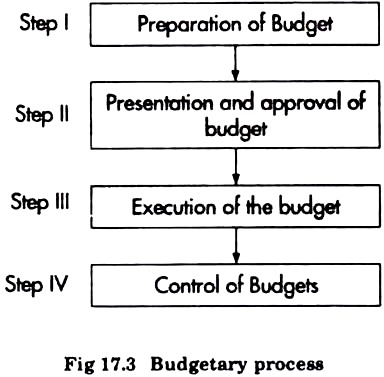After reading this article you will learn about the budgetary process for advertising of products.
The advertising budgeting process involves the following steps (Fig. 17.3):
Step-I:
ADVERTISEMENTS:
Preparation of Budget:
It is generally prepared by advertising manager in consultation with marketing manager. The advertising budget made is based on inputs provided by marketing research people. The budget is generally made on annual basis. Primary input would depend upon type of product, new or established one, target market, demography composition, advertising copy and media selection etc.
Step-II:
Presentation and approval of Budget:
ADVERTISEMENTS:
After the budget is made, it is presented to top management for the approval of the budget.
Step-III:
Execution of the Budget:
After the budget is approved by the top management, it is executed. Various channels and media for budget allocation are considered. The task of preparing advertising messages and acquiring advertising time and space is given to advertising agency.
ADVERTISEMENTS:
Step-IV:
Control of Budget:
After the budget is executed, the results come out. If control of budgets involve comparing the desired advertising objectives and actual advertising objectives The purpose is to know the effectiveness of advertising in-terms of money allocated to advertising If it is found that the allocated budget is on the higher side or on the lower side the appropriate corrective action can be taken.
Length of Budget Period:
ADVERTISEMENTS:
The establishment of a budget requires a period to be covered by budget. Various businesses are subject to different influences and hence, different periods may be used in budgeting the advertising activity for the company. As a result, the nature of the business and the objectives for the appropriation are generally the determinants of the logical length of the budget period.
For companies who have a regular pattern of sales, the annual budget is more frequently used. Within this frame work, however, the following periods can be considered:
1. The advertising budget may be prepared for a fixed period of three months, six months or a year.
2. Budget may be kept a certain period in advance of the current by adding a new month to the forecast as each month is completed.
ADVERTISEMENTS:
3. A combination of a summary containing long term advertising budget and a more detailed short term advertising budget can be used to provide a long term plan and to provide detailed co-ordination and control over a shorter term.
Regardless of what period is selected, there are inherent advantages to subdividing the advertising by months and then using this data to serve for the day-to-day and week-to-week decisions that have to be made for control of advertising expenditures.
Budget Flexibility:
A firm that sets the amount for advertising one year in advance should permit a certain amount of flexibility in its budgeting for advertising. Even when the appropriation is set for a shorter period or for only one specific campaign for a specific product, flexibility is necessary in order to meet changing and unforeseen conditions that may emerge in the market.
ADVERTISEMENTS:
During the period, generally economic conditions may change, and an unpredicted slump or rise in general economic activity may occur. In addition to general economic conditions, other changes may take place. The firm itself may decide to shift plans upon which the budget was based. It may decide that it should enter new markets or due to some unforeseen developments, it may decide to expand its product line.
By the same token, decisions to drop lines or to limit the market might call for decreasing the sums for advertising. Advertising plans are also usually predicated on certain assumptions regarding the competitive strategy of other companies.
Should this competitive situation change markedly during the budget period, it may be essential to allocate a different amount for advertising to achieve the desired objectives. Conceivably, it is possible for sudden changes to occur in the dealer situation in specific markets that would call for increase or decrease in the dealer allocation for the advertising campaign.
Whatever the reason, it is important to provide flexibility in the budgeting strategy in order to meet changing conditions, assuming of course that the financial position of the firm makes its feasible. It is also recommended that a certain amount for contingencies be included in the advertising budget.
ADVERTISEMENTS:
If changes occur that would require a limited increase in the amount of spending, such increase could be handled through the contingencies reserve. Another means for providing flexibility is to have a periodic and reasonably frequent review of the budget and to compare the expenditures with the original appropriation in order to check the progress in attaining the objectives.
